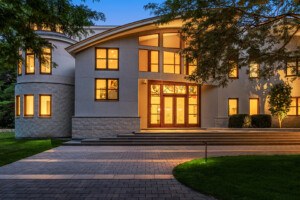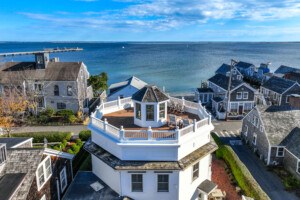Michelle Wu Has Big (Progressive) Ideas for the City

Photograph by Ken Richardson
When she became president of the Boston City Council in January 2016, Michelle Wu was just the third woman to hold the office, and the first Asian American. Fresh from a tour of Amsterdam and Copenhagen, the Harvard Law grad has put sustainability and safe streets high on her wish list for the city. But we knew we’d found a true hero when she began bicycle commuting in July. Here, Wu talks all things Boston.
Tell us about your trip to northern Europe. Why did you go?
The overall focus was on seeing firsthand how other cities are managing climate change and adaptation resiliency. You hear all the time about the challenges of making these adjustments in Boston—that because our infrastructure’s very old and the streets are very narrow, you can’t possibly carve out room for bike lanes, or cycle tracks. But these cities are the same density, even older than Boston, and it’s really eye-opening to see how well they’re doing it.
How is the northern European approach different from ours?
They frame their actions around resiliency—not around avoiding risk, but enhancing opportunity. Look at our guide, Vision Zero Boston. It’s crashes, crashes, crashes. These are the numbers of [accidents and] fatalities every year, and here’s how we have to change that.
But Boston’s climate plan could be about opportunity: how we can enhance the city overall to create more civic space, or enhance the property values of an area, or bring more economic development to a neighborhood. We could frame our approach to climate change in a very positive and inclusive light.
Once you change the infrastructure to make it safe and separated, then the types and numbers of cyclists will change dramatically. Stand on the corner of an intersection in Copenhagen, and in five minutes there are moms with kids, men in suits biking home from work, women with baby carriers strapped to them, and people with their groceries on a big cargo bike.
So you’re bicycle commuting regularly now?
I would, except daycare’s at City Hall, and I don’t feel safe biking down Washington Street with my son in the back seat.
Along with climate change, what’s the most pressing problem Boston faces?
If you could only name one, it’s unequal access to opportunity. The city is experiencing so much success right now, but it’s not a success that everybody shares in. From housing affordability to educational opportunity, so many of the barriers to success are unequally concentrated on communities of color, residents of color, and low-income residents.
How does our transportation system create inequality?
There are still places in Boston where you can find a more affordable—relatively affordable—place to live, but then it’s very difficult to get to work, to the grocery store, to the doctor, etc. So transportation and housing affordability are very closely linked.
Biking is a cost-effective mode of transportation. It’s affordable; it’s safe; it’s sustainable; and it helps connect us neighborhood to neighborhood and not just neighborhood to downtown.
How else should the city deal with the affordability issue?
We need to focus on zoning. How are we planning for the future, and what kind of city do we want to have? If we want families, we should lay out the regulations to get us there. In Vancouver in the ’90s, for example, the city specified multi-bedroom, family-friendly units for its downtown. The development community said that if the city made demands about how that would get built, it would be too hard to develop. They did it anyway. They demanded large units for families to be built in the city center, and now there are all these kids living downtown.
You talk a lot about local businesses. Why are they important?
Our locally owned small businesses are still the heart of our neighborhoods because that’s where the jobs are. That’s what keeps wealth in communities. We’re seeing many small-business districts across the city struggling—some to fill vacancies in their business districts, and some to hold onto the fabric of what makes that main street’s district special. And many are becoming victims of their own success. In the South End, for example, or in Roslindale—where the local small businesses have really anchored revitalization and interest in moving to those neighborhoods—they’re now facing a lot of pressure as rents go up and national chains step in.
How has your perception of Boston changed since you first got here?
My entry point into Boston was as an undergrad in Cambridge at Harvard. I remember studying the MBTA map to learn where all the different lines intersected. And I remember the day that I realized that Park Street and Haymarket were actually within walking distance. Because the map’s not to scale, I would always just take the T and change, change, change to get closer to Chinatown or the North End. I didn’t realize Boston was actually a very walkable city.
It’s walkable, but it’s also getting more dangerous.
We have seen the number of pedestrian fatalities from crashes increasing dramatically. Boston has among the highest percentages of pedestrian commuters of any major city. And that’s only increasing as we see more residential development downtown. So as more and more people are walking on the streets, and cycling as well, the attention to traffic calming and preventing crashes is going to become more and more important.
And autonomous vehicles are right around the corner, so…
I’m not a big fan, because the idea is really to get cars off the street.
As the founder of Zipcar said, there are two possible futures: Either self-driving cars increase traffic because—let’s say a family owns one, and adult number one gets dropped off at work, they send the car home to pick up adult number two, drop them, pick up the dry cleaning. In that scenario, you’re increasing traffic when everyone’s doing this. Or we can push people toward carpooling to reduce the number of vehicles, because each shared car can more efficiently route to pick up multiple people. Then you can give up these large downtown parking lots, or parking garages, and turn them into civic spaces. It’s actually really, really fascinating.
We talk about creating safe streets, but who’s responsible for laying out a plan?
It’s overseen by the Boston Transportation Department, and now Boston Bikes has its own department within the BTD. So between them, they manage the city’s bike plan, which is a great directional document.
What are some of the obstacles to implementing a safe street plan?
I think it’s about building a capacity internally to design and implement the projects.
The engineering staff of the BTD and the engineering staff in other departments are stretched pretty thin, because there’s so much happening across the city. So I will be pushing for more funding for proactive design and integrating transportation planning into all the development planning that mostly happens at the Boston Planning & Development Agency.
I also think there should be more public engagement in the creation of concrete to-do lists. To some extent, that’s happening with Go Boston 2030, the city’s master plan for transportation.
Maybe the BPDA demands that buildings produce their own energy, like the wind turbines on that new Boylston Street project.
We have one on City Hall, too. It powers a light bulb somewhere.
And it’s not like we don’t have any wind.
We have very good wind! I’m aware there’s different qualities of wind, too, just like there are different qualities of solar, and the New England coast wind is very, very good. And Denmark is 42 percent wind.
And that GE building with that enormous solar veil—I think we need to demand more of developers.
We’re very good at talking about construction mitigation: Where do you park the trucks that are bringing all the construction materials? Are you creating affordable housing, and can you do it on-site? But we should also be asking other questions: Are you contributing to the sustainable multi-modal transportation network? Are you thinking about leaving room or even building a cycle track as part of the construction, or providing funding for the design of some other piece of the network that we need?
Most of the bike community doesn’t want additional cars.
It’s interesting, because I’m pushing for more electric vehicle infrastructure, and everybody’s also saying, well, why are we allowing any cars to be added? But we’re seeing high incidents of asthma from pollution and all that, so in my mind, we need to be working on reducing emissions. It’s a given that we’re going to be working toward cleaner, renewable energy, but at the same time, every car we can get to shift from gas to electric is less asthma, less pollution.
What have you learned about this city’s architecture and design since you started biking?
When you’re walking, you absorb everything; you can hear conversations; you smell what’s around you; you can see the textures of buildings and everything up close, but you only see so much.
But when you’re biking, you can get up to car-ish speed, and you’re still completely exposed to the world around you. You can even stop if you stumble upon some interesting festival that’s happening or a building that just seems really out of the ordinary.
It’s totally different from being sealed off in a car, where you’re going by a lot and you’re absorbing it visually to the extent that you can take your eyes off the road, but you’re not really breathing it in.
Biking gives you the best of both worlds—you’re able to get to where you need to go quickly, but you can also see everything along the way.


